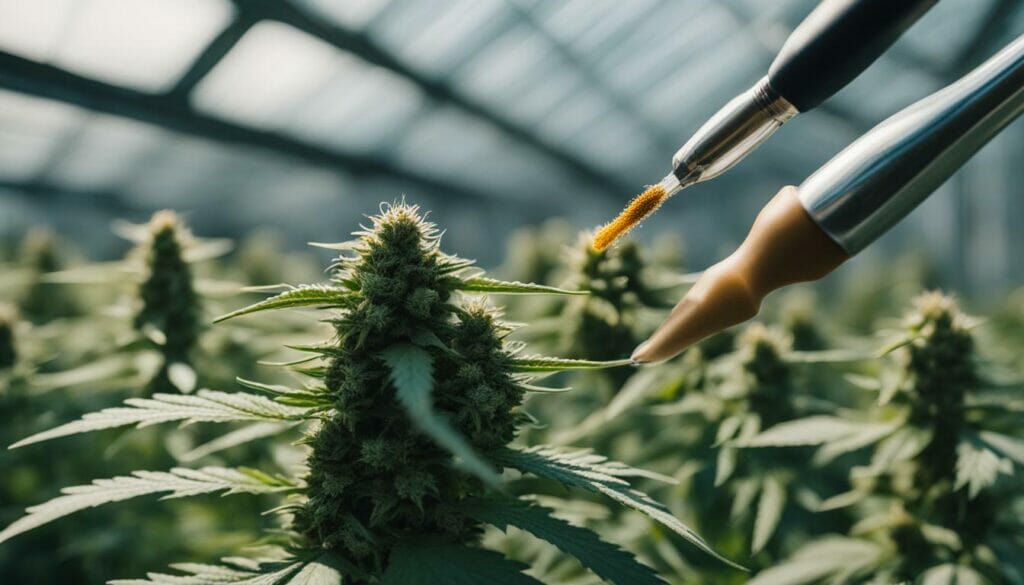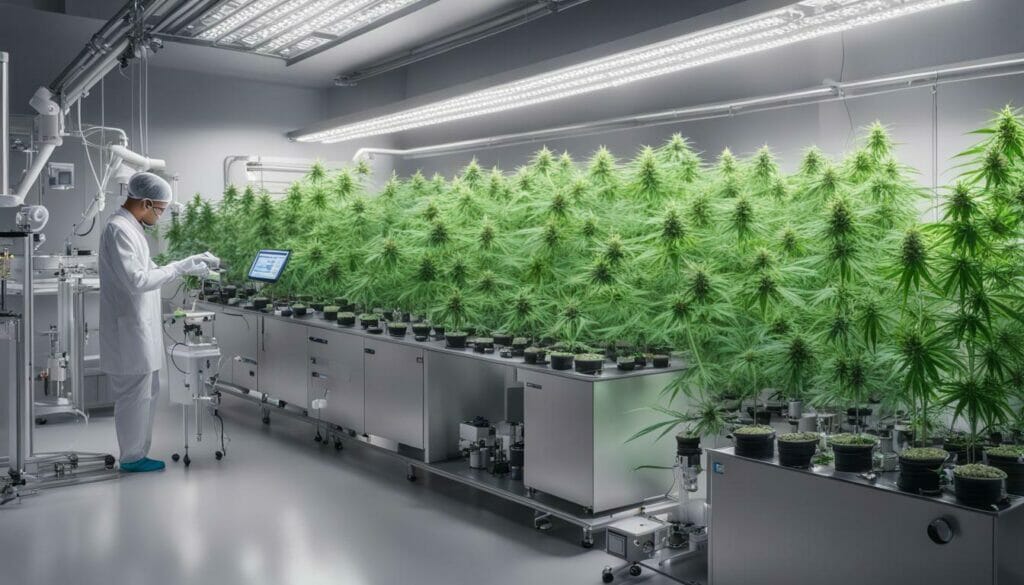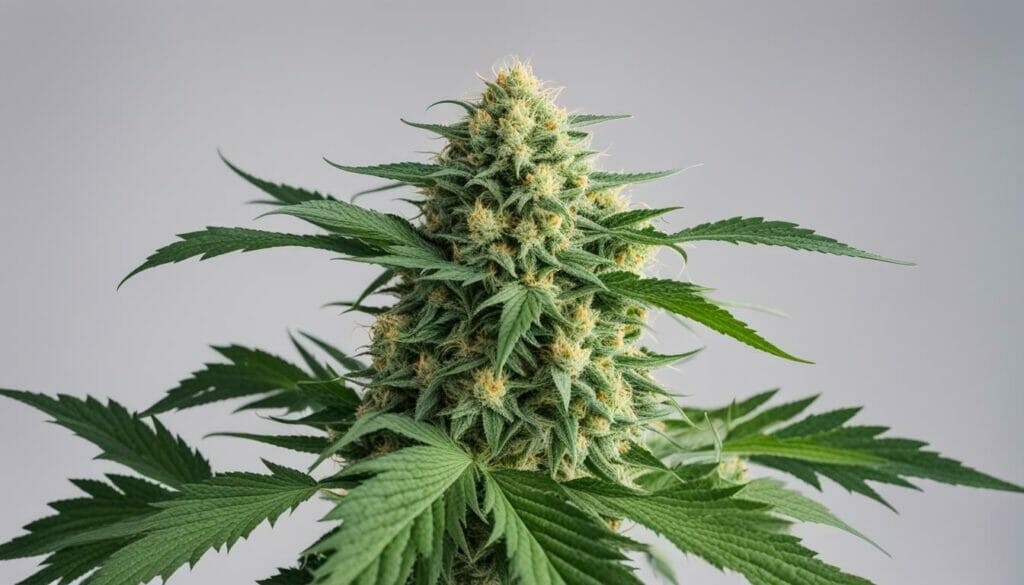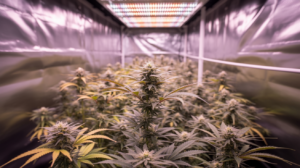Guide to Understanding the Science Behind Cannabis Breeding

In recent years, the cannabis industry has experienced an explosion of interest in breeding new and unique strains of cannabis plants. This has led to the development of new and exciting hybrids that offer different flavors and effects than traditional cannabis strains. However, behind this innovation lies a complex and fascinating science that combines genetics, botany, and horticulture. In this guide, we will explore the basics of cannabis breeding, the genetics of cannabis, traditional and modern breeding techniques, and strategies for successful breeding.
Key Takeaways:
- Understanding the science of cannabis breeding is essential for successful cultivation and strain development.
- Cannabis breeding involves a combination of genetics, botany, and horticulture.
- The development of new and unique cannabis strains requires an in-depth understanding of plant genetics and the various techniques used to modify them.
What Is Cannabis Breeding?
Cannabis breeding is the deliberate manipulation of the plant’s genetics to create new and improved cannabis strains with desirable traits. The goal of cannabis breeding is to enhance specific characteristics of cannabis plants such as flavor, potency, yield, and resistance to pests and diseases.
To achieve this, breeders use a variety of techniques that involve crossing two or more plants with desirable traits to create offspring with a unique combination of these traits. The offspring are then selectively bred over several generations to stabilize the desired traits and eliminate undesirable ones.
The process of cannabis breeding requires a deep understanding of cannabis genetics, including the role of different genes and how they interact to produce specific traits. By harnessing this knowledge, breeders can create unique cannabis strains that are tailored to meet the needs of consumers and cultivators alike.

Cannabis breeding is the deliberate manipulation of the plant’s genetics to create new and improved cannabis strains with desirable traits.
The Basics of Cannabis Genetics
Understanding the genetics of cannabis is crucial for successful breeding and cultivation. Plants, including cannabis, have two sets of chromosomes inherited from their parents. Each chromosome contains DNA, the genetic code that determines the plant’s traits and characteristics. Cannabis plants have 10 pairs of chromosomes, resulting in a total of 20 chromosomes.
For cannabis breeders, it is essential to understand the different types of genes that contribute to the plant’s traits. These include:
| Gene Type | Description |
|---|---|
| Dominant Genes | Genes that express their traits when paired with a recessive gene. |
| Recessive Genes | Genes that express their traits only when paired with another recessive gene. |
| Co-Dominant Genes | Genes that express a mixture of traits when paired with another co-dominant gene. |
Understanding the different types of genes is crucial for creating desirable traits in cannabis plants. Breeders can select plants with specific genes and cross them with other plants to create new and unique combinations of genes. This process is known as plant breeding.

Plant breeding can result in a wide range of phenotypes, or observable traits, in cannabis plants. These can include differences in plant height, leaf shape, flower structure, and cannabinoid content. By understanding the genetics of cannabis and how different genes contribute to these traits, breeders can develop new strains with specific characteristics and qualities.
However, it’s important to note that genetics is just one aspect of successful cannabis breeding. Other factors, such as environmental conditions and cultivation techniques, can also influence a plant’s traits. Therefore, it’s important for breeders to take a holistic approach to cannabis cultivation and breeding, considering all aspects of the plant’s growth and development.
The Importance of Plant Breeding in Cannabis
Cannabis breeding plays a crucial role in the cultivation and development of new and unique cannabis strains. Through selective breeding and hybridization, breeders can manipulate the genetic makeup of cannabis plants to create strains with specific traits such as flavor, aroma, potency, and disease resistance.
But why is this important? First and foremost, breeding helps to improve the quality and potency of cannabis. By carefully selecting parent plants with desirable traits and crossbreeding them, breeders can produce offspring with even more desirable traits. This results in higher-quality cannabis that consumers enjoy and value.
Cannabis breeding also supports the growth and sustainability of the cannabis industry. As more and more states legalize cannabis for both medical and recreational use, there is a growing demand for new and unique strains. Breeders can meet that demand by developing new strains that are better suited to specific growing conditions or consumer preferences.
Beyond the commercial benefits, cannabis breeding also plays an important role in plant science and genetics research. As breeders manipulate and study the genetics of cannabis plants, they contribute to our understanding of plant genetics as a whole. This knowledge can be applied to other crops and plants, potentially leading to advancements in agriculture and food production.

Plant breeding is a critical component of the cannabis industry, supporting quality, sustainability, and innovation. As the industry continues to evolve, it is likely that we will see even more advances in cannabis breeding techniques and technologies.
Traditional Cannabis Breeding Methods
Traditional cannabis breeding methods refer to selective breeding and backcrossing. Selective breeding is a process where breeders choose plants with desirable traits to use as parent plants in the next generation. By selecting plants with desirable traits, breeders can create new strains with specific characteristics.
Backcrossing is a process where breeders cross a hybrid plant with one of its parent plants. This process is used to reinforce desirable traits from the parent plant into the hybrid. Breeders may use this process to create stable strains with consistent characteristics.
Both selective breeding and backcrossing are time-consuming processes that require a lot of patience and attention to detail. However, they are valuable methods for creating new and unique cannabis strains.

Selective breeding is like being a matchmaker for plants. You have to understand what each plant brings to the table and how to combine them to create the perfect match.
While traditional breeding methods have been successful in creating countless cannabis strains, they have some limitations. These methods rely on natural genetic variation, which can be unpredictable, making it difficult to achieve specific desired traits.
Additionally, traditional breeding methods are often prone to inbreeding, which can lead to a loss of genetic diversity and the expression of undesirable traits. To overcome these challenges, breeders have turned to modern techniques in cannabis breeding.
Modern Techniques in Cannabis Breeding
Cannabis breeding has come a long way over the years, and modern techniques have revolutionized the field. Here are some of the most advanced techniques used by cannabis breeders today:
| Technique | Description |
|---|---|
| Tissue Culture | A technique used to grow new plants from a small piece of plant tissue in a sterile lab environment. This allows breeders to produce genetically identical clones and to maintain desirable traits. |
| Genetic Modification | A technique used to modify the DNA of cannabis plants, allowing breeders to introduce new traits or remove unwanted ones. This can be achieved through techniques such as CRISPR/Cas9 gene editing. |
| Marker-Assisted Breeding | A technique used to identify and select specific sections of the cannabis genome associated with desirable traits. This allows breeders to more efficiently develop new strains and reduce the time and cost of breeding. |
Modern techniques in cannabis breeding have allowed for more precision and control in developing new strains. With the ability to manipulate the genome of cannabis plants, breeders can achieve desirable traits with greater efficiency and accuracy.

Understanding Phenotypes and Genotypes in Cannabis Breeding
In cannabis breeding, understanding phenotypes and genotypes is crucial for achieving desired traits in plants.
Genotype refers to the genetic makeup of an organism, including the specific combination of genes that determine its traits. In cannabis, different genotypes can produce a wide variety of traits, such as aroma, taste, potency, and plant structure.
Phenotype, on the other hand, refers to the physical expression of those genes, which can be influenced by both genetic and environmental factors. Phenotypic traits can include plant height, leaf shape, flower color, and resin production.
Understanding the relationship between genotypes and phenotypes is essential for cannabis breeders, as they can use this knowledge to selectively breed plants with desired traits. By selecting parent plants with specific genotypes, breeders can increase the likelihood of producing offspring with the desired phenotypic traits.
It’s important to note that phenotypic traits may not always be a direct reflection of the underlying genotype. Environmental factors such as temperature, light, humidity, and nutrients can also affect the expression of traits. Therefore, it’s essential for breeders to carefully control the environment in which plants are grown to ensure consistency in phenotypic expression.

Another important consideration is genetic diversity. While selective breeding can produce plants with desired traits, it can also reduce genetic diversity within a population. This can lead to an increased risk of genetic disorders or susceptibility to disease. To maintain genetic diversity, breeders may incorporate new genetic material into their breeding programs through hybridization or other techniques.
Understanding the relationship between genotypes and phenotypes is crucial for successful cannabis breeding. By carefully selecting parent plants and controlling the environment in which they are grown, breeders can produce offspring with the desired traits, while maintaining genetic diversity and minimizing the risk of genetic disorders.
Strategies for Successful Cannabis Breeding
Successful cannabis breeding requires careful planning and attention to detail. Here are some practical strategies to help you achieve your breeding goals:
Select the Right Parent Plants
The parent plants you choose will have a significant impact on the traits expressed in their offspring. Select plants with desirable traits such as high yield, potency, or disease resistance. It’s also important to choose plants with compatible genetics to ensure successful crossbreeding.
Control Pollination
Controlling pollination is crucial for successful cannabis breeding. To prevent unwanted cross-pollination, keep male plants away from female plants until you’re ready to breed them. You may also want to consider using isolation tents or cages to prevent accidental cross-pollination.
Maintain Genetic Diversity
Maintaining genetic diversity is essential for long-term breeding success. Avoid inbreeding by incorporating new genetics into your breeding program regularly. This helps prevent genetic drift and ensures your plants remain healthy and vigorous.
Monitor and Record Your Results
Keep detailed records of your breeding experiments, including parent plant genetics, breeding methods, and resulting offspring traits. This will help you identify successful breeding strategies and track the progress of your breeding program.
Experiment with Different Breeding Techniques
Traditional breeding methods such as selective breeding and backcrossing are effective but can be time-consuming. Consider experimenting with modern techniques such as tissue culture, genetic modification, and marker-assisted breeding to speed up the breeding process and achieve your desired trait combinations.

By following these strategies and staying up to date with the latest advances in cannabis breeding techniques, you can produce high-quality cannabis strains that meet the needs of both recreational and medicinal users.
The Future of Cannabis Breeding
The field of cannabis breeding is constantly evolving, with new techniques and technologies emerging all the time. One such technology is CRISPR-Cas9, which allows for precise genetic editing of cannabis plants. This has the potential to revolutionize cannabis breeding, enabling breeders to target specific genes and traits with greater accuracy.
Another area of focus in cannabis breeding is the use of machine learning and artificial intelligence to analyze plant data and predict outcomes. This could help breeders identify the most promising parent plants and optimize breeding strategies for desired trait expression.
Advancements in cannabis genetics also have the potential to improve the medicinal properties of cannabis. For example, researchers are studying how specific cannabinoids and terpenes can help treat various medical conditions, such as chronic pain, anxiety, and epilepsy. As we learn more about the genetics of cannabis, we may be able to develop strains with targeted medicinal benefits.
The future of cannabis breeding is exciting and full of potential. As technology continues to advance, we can expect to see even more innovative breeding techniques and new, unique cannabis strains that offer a range of medicinal and recreational benefits.

The Role of SeedsHereNow.com in Cannabis Breeding
When it comes to cannabis breeding, having access to reliable seeds is crucial. That’s where SeedsHereNow.com comes in. As one of the best USA seed banks, they offer a wide variety of high-quality cannabis seeds from some of the most reputable breeders in the industry.
The team at SeedsHereNow.com takes pride in their commitment to providing growers with top-notch genetics and exceptional customer service. They offer a vast selection of both regular and feminized cannabis seeds, as well as auto-flowering and high-CBD strains.
One of the great things about SeedsHereNow.com is their dedication to transparency. Each seed they sell comes with detailed information about its genetics, including the lineage and characteristics of the parent plants. This information is invaluable to cannabis breeders looking to create new and unique strains.
Whether you’re a professional cannabis breeder or a hobbyist cultivator, SeedsHereNow.com is an excellent source of high-quality cannabis seeds. Their commitment to quality and transparency makes them a reliable partner for anyone looking to breed exceptional cannabis strains.
Conclusion
Understanding the science behind cannabis breeding is crucial for successful cultivation and strain development in the cannabis industry. Cannabis breeding is a complex process that involves a deep understanding of plant genetics and the techniques used to manipulate them. It requires careful selection of parent plants, control of pollination, and maintenance of genetic diversity to produce the desired traits.
The future of cannabis breeding holds great potential, with emerging technologies that may revolutionize the field. These advancements will allow breeders to develop new and unique cannabis strains with even more precise traits.
At SeedsHereNow.com, we understand the importance of reliable seed sources for cannabis breeders and cultivators. As a top cannabis seed bank in the USA, we are committed to providing the highest quality seeds to our customers.
Overall, cannabis breeding is an exciting and evolving field that requires dedication, patience, and knowledge. By understanding the science behind cannabis breeding and staying up to date with emerging technologies, breeders can achieve greater success in producing unique and high-quality cannabis strains.
FAQ
Q: What is cannabis breeding?
A: Cannabis breeding is the process of manipulating the genetics of cannabis plants to create new and desirable traits. This involves crossbreeding different strains and selecting for specific characteristics.
Q: Why is understanding cannabis genetics important in breeding?
A: Understanding cannabis genetics is crucial in breeding because it allows breeders to predict and manipulate the traits that will be expressed in the offspring. It helps breeders create new strains with specific characteristics.
Q: What are the traditional methods of cannabis breeding?
A: Traditional methods of cannabis breeding include selective breeding, which involves choosing plants with desirable traits and breeding them. Backcrossing is also commonly used to stabilize traits in a strain.
Q: What are some modern techniques used in cannabis breeding?
A: Modern techniques in cannabis breeding include tissue culture, genetic modification, and marker-assisted breeding. These techniques allow breeders to manipulate genes more efficiently and accurately.
Q: How do phenotypes and genotypes influence cannabis breeding?
A: Phenotypes are the observable characteristics of a plant, while genotypes are the genetic makeup. Breeders use phenotypic and genotypic information to select parent plants with desired traits and to understand how those traits are inherited.
Q: What are some strategies for successful cannabis breeding?
A: Some strategies for successful cannabis breeding include selecting healthy and vigorous parent plants, controlling pollination to prevent unwanted cross-pollination, and maintaining genetic diversity to avoid inbreeding depression.
Q: What is the role of SeedsHereNow.com in cannabis breeding?
A: SeedsHereNow.com is a top cannabis seed bank in the USA, providing breeders and cultivators with reliable and high-quality seeds. It plays a crucial role in ensuring that breeders have access to the genetic resources they need for successful breeding.
Suggested Articles
;)
;)
;)




 08 Jul 2025
08 Jul 2025  4 min read
4 min read


 October 08, 2023
October 08, 2023 


RESPONSES (0)
No responses yet. Be the first to respond!